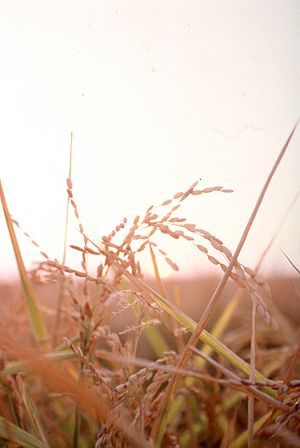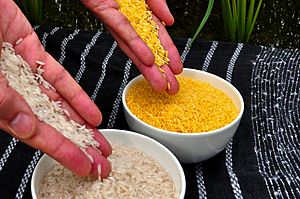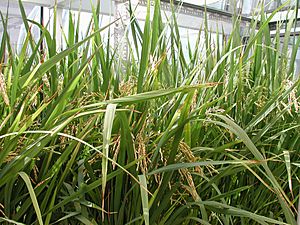Genetically modified rice facts for kids
Genetically modified rice is a type of rice that has been changed using genetic engineering. This means scientists have added or removed specific genes from the rice plant. They do this to give the rice new features.
For example, GM rice can have more healthy nutrients like vitamin A. It can also grow faster or be stronger against pests and weeds. Some GM rice can even make special human proteins.
Sometimes, genes can move naturally between different types of plants. This can happen with rice too. However, growing and using genetically modified rice is still a debated topic. Some countries do not allow it.
Contents
History of GM Rice
In 2000, the first two types of GM rice were approved in the United States. These rice types were made to resist herbicides, which are chemicals used to kill weeds. Later, other countries like Canada and Australia also approved these types of GM rice. But even with approval, these GM rice types were not widely sold or grown.
In 2009, China gave safety approval to a type of GM rice that could resist pests. However, this rice was also not sold to farmers. By 2012, GM rice was still not common. Scientists believe that improving rice could help feed more people. This is because rice is a main food for many people around the world.
In 2018, Canada and the United States approved golden rice for growing. Health officials in both countries said it was safe to eat.
By 2021, a special "seawater" rice was being grown in China. This rice can grow in salty soil. Farmers planted it on a very large area, and it produced a good amount of rice.
Special Features of GM Rice
Resisting Weeds
Some GM rice is made to resist herbicides. This means farmers can spray chemicals to kill weeds, but the rice plant will not be harmed. One type, called LibertyLink rice, can resist a chemical called glufosinate. Another type, Clearfield rice, was developed using traditional breeding methods. It can resist other types of herbicides.
More Nutrients
One famous type of GM rice is Golden rice. It was created to have more Vitamin A. This rice makes a substance called beta-carotene in its grain. Our bodies use beta-carotene to make vitamin A. This is important because many people around the world do not get enough vitamin A.
Scientists are also working to increase the amount of iron in rice. Iron deficiency is a big problem for many people. Researchers have changed some rice plants to have more iron and zinc.
Fighting Off Pests
Bt Rice
BT rice is a type of GM rice that can fight off pests. It has a special gene from a bacterium called Bacillus thuringiensis. This gene helps the rice make a natural poison that harms pests like the rice borer. This means farmers do not need to spray as many harmful chemicals on their crops.
Farmers who grow BT rice can get more rice from their fields. China approved this rice for wide use in 2009.
Stopping Allergies
Scientists in Japan are trying to create rice that causes fewer allergies. They are working to stop the rice from making a protein that can cause allergic reactions.
Japanese researchers also tested GM rice that could help with hay fever. This rice contains proteins from cedar pollen. Eating this rice might help people become less sensitive to cedar pollen, which causes sneezing and itchy eyes.
Growing Faster with C4 Photosynthesis
Scientists are trying to make rice grow much faster. They are working to give rice a special way of making food called C4 photosynthesis. This is how plants like corn and sugarcane grow so quickly. If rice could use C4 photosynthesis, it might produce about 50 percent more food. This is a very complex project, as it requires many changes to the rice plant.
Making Human Proteins
Scientists can also use GM rice to make special human proteins. One example is human serum albumin (HSA). This protein is found in human blood and is used to treat serious injuries like burns. It is often in short supply.
In China, scientists have made brown rice that can produce HSA protein. This could be a cheaper way to get this important medicine. This special rice makes the same HSA protein as humans. Clinical trials for this protein started in China in 2017.
Another company uses GM rice to make proteins found in human breast milk. These proteins are used in infant formula and special rehydration drinks for babies.
Surviving Floods
Rice grows in water, but it can still be damaged by floods. In 2010, floods caused a loss of millions of tons of rice in India and Bangladesh. Scientists found a single gene, called Sub1A, that helps rice survive underwater for up to two weeks. Adding this gene can protect rice crops from floods.
Tolerating Salt
Scientists have also created rice that can grow in salty soil. This is important for areas where the soil has too much salt. They did this by changing how two genes in the rice plant work together.
Experimental Research
Scientists are always trying new things with GM rice. For example, they are looking at ways to make rice more resistant to certain plant diseases.
Legal Issues
United States
In 2006, a small amount of an unapproved GM rice type was found in rice shipments from the United States. This rice type, called LL601, was not approved for food. This caused problems for farmers who sold rice to other countries. Japan and Russia stopped buying rice from the U.S. for a while.
The company that made the rice, Bayer, later agreed to pay a large amount of money to farmers who lost sales. The exact reason for the mix-up was never fully discovered.
China
The Chinese government does not allow GM rice to be sold for commercial use. All GM rice in China is only approved for research.
Scientists have discussed if growing large amounts of GM rice could cause problems. For example, could the modified genes spread to other rice plants? They believe this is not a big problem because rice usually self-pollinates. This means it mostly fertilizes itself, so genes are less likely to spread to other plants. However, some studies suggest that insects might spread genes more than expected.
See also
 In Spanish: Arroz genéticamente modificado para niños
In Spanish: Arroz genéticamente modificado para niños




